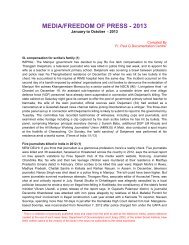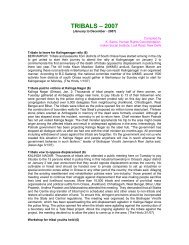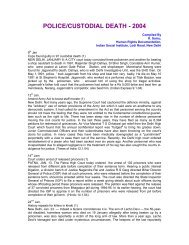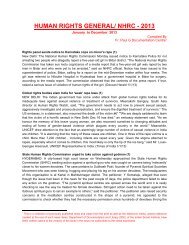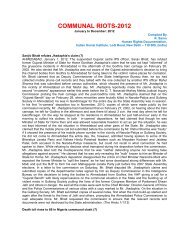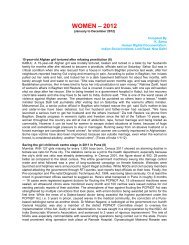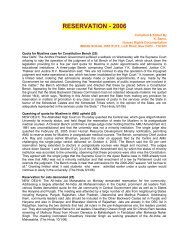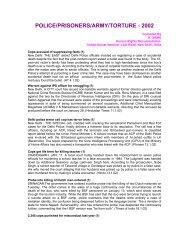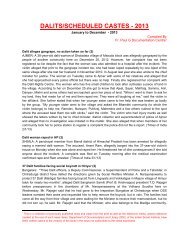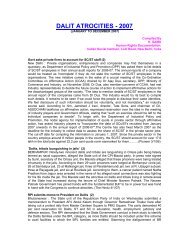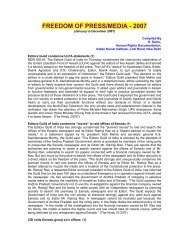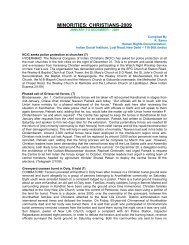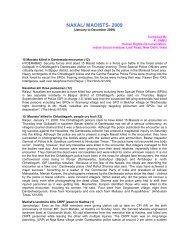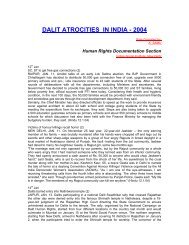Communal Violence and Inter-Community Relations - Indian Social ...
Communal Violence and Inter-Community Relations - Indian Social ...
Communal Violence and Inter-Community Relations - Indian Social ...
You also want an ePaper? Increase the reach of your titles
YUMPU automatically turns print PDFs into web optimized ePapers that Google loves.
COMMUNAL VIOLENCE AND INTER-COMMUNITY RELATIONS 35<br />
rupture in community relations, the adversaries must have a sense of<br />
collective identity about themselves <strong>and</strong> about others against whom<br />
they are supposedly juxtaposed. And in the process of conflict each<br />
side believes that the fight is between us <strong>and</strong> them. Developing a sense<br />
of self is an essential part of every individual’s evolutionary pattern<br />
within the larger community identity. Each person’s self-conception is a<br />
distinctive combination of several identifications based on gender, class,<br />
sect, religion etc. Although identity of the self may apparently coincide<br />
with a particular human being, identities per se are actually much wider<br />
than that. In their best perceived sense, identities are collective <strong>and</strong><br />
they stretch beyond borders created by the states <strong>and</strong> the governments.<br />
Locating identity in our times Bauman (2004) writes: “In our world of<br />
rampant ‘individualisation’, identities are mixed blessings. They vacillate<br />
between a dream <strong>and</strong> a nightmare, <strong>and</strong> there is no telling when one will<br />
turn into the other. At most times the two liquid modern modalities of<br />
identity cohabit, even when located at different levels of consciousness.<br />
In a liquid modern setting of life, identities are perhaps the most common,<br />
most acute, most deeply felt <strong>and</strong> troublesome incarnations of<br />
ambivalence.<br />
Moving a little further, we also realise that hegemonic superimpositions<br />
too create <strong>and</strong> construct identities for the individuals <strong>and</strong> the groups.<br />
And on account of the pervasive impact of these constructed identities,<br />
people feel (or are made to feel) injured when other persons sharing<br />
their identity are injured or killed. It should be stressed that huge physical<br />
distance is no check that the images seen <strong>and</strong> perceived shall not cross<br />
administrative borders <strong>and</strong> boundaries. Identities are constructed on<br />
the basis of various traits <strong>and</strong> experiences <strong>and</strong> there are large numbers<br />
of players engaged in the vocation of identity construction. Several of<br />
those characteristics, which are presented as sets of identity markers<br />
are in reality open to different readings, interpretations <strong>and</strong> explanations.<br />
Identities are portrayal of the self as also attributes projected on to<br />
others. They also indicate not only who we are but what others think<br />
of who we are. Bauman (2004) depicts the distinction between choices<br />
<strong>and</strong> free will of some on the one h<strong>and</strong> <strong>and</strong> of incapacitated on the other<br />
h<strong>and</strong>, others as far as identities are concerned. “Let me note that<br />
identification is also a powerful factor in stratification; one of its most<br />
divisive <strong>and</strong> sharply differentiating dimensions. At one pole of the



